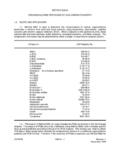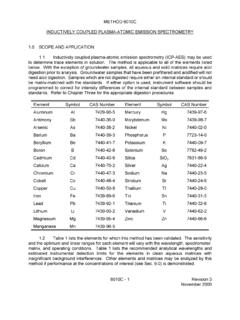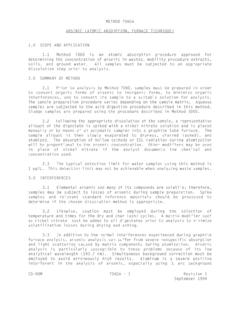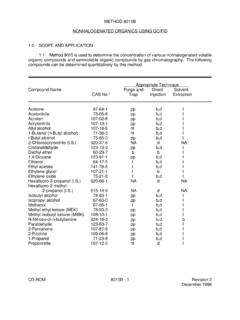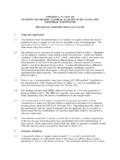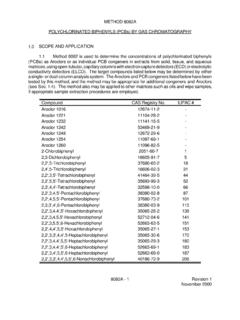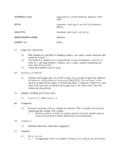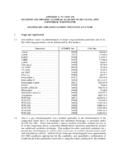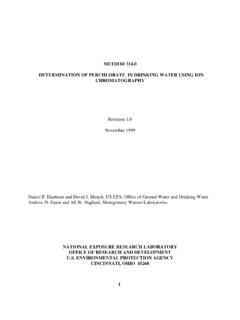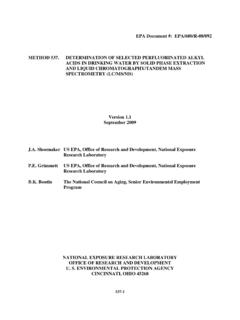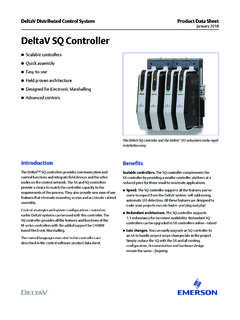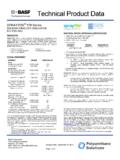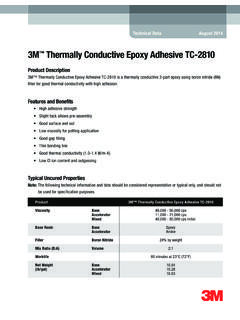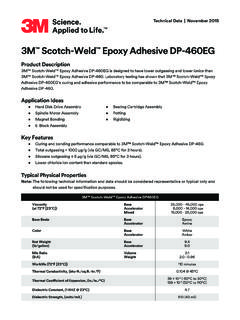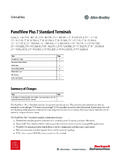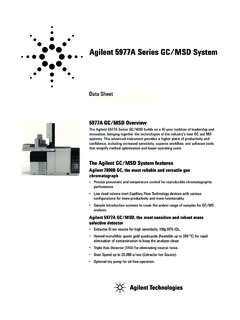Transcription of METHOD 552.2 DETERMINATION OF HALOACETIC …
1 OF HALOACETIC ACIDS AND DALAPON IN DRINKING WATERBY LIQUID-LIQUID EXTRACTION, DERIVATIZATION AND GASCHROMATOGRAPHY WITH ELECTRON CAPTURE DETECTIONR evision Hodgeson (USEPA), J. Collins and Barth (Technology Applications Inc.) - METHOD , (1990) Hodgeson (USEPA), D. Becker (Technology Applications Inc.) - METHOD , (1992) Munch, Munch (USEPA) and Pawlecki (International Consultants, Inc.), METHOD , Rev. , (1995)NATIONAL EXPOSURE RESEARCH LABORATORYOFFICE OF RESEARCH AND ENVIRONMENTAL PROTECTION AGENCYCINCINNATI, OHIO OF HALOACETIC ACIDS AND DALAPONIN DRINKING WATER BY LIQUID-LIQUID EXTRACTION, DERIVATIZATIONAND GAS chromatography WITH ELECTRON CAPTURE AND is a gas chromatographic (GC) METHOD applicable to the DETERMINATION of1-8the listed halogenated acetic acids in drinking water, ground water, raw sourcewater and water at any intermediate treatment stage.
2 In addition, the chlorinatedherbicide, Dalapon, may be determined using this NumberChemical Abstract ServicesBromochloroacetic Acid (BCAA)5589-96-3 Bromodichloroacetic Acid (BDCAA)7113-314-7 Chlorodibromoacetic Acid (CDBAA)5278-95-5 Dalapon75-99-0 Dibromoacetic Acid (DBAA)631-64-1 Dichloroacetic Acid (DCAA)79-43-6 Monobromoacetic Acid (MBAA)79-08-3 Monochloroacetic Acid (MCAA)79-11-8 Tribromoacetic Acid (TBAA)75-96-7 Trichloroacetic Acid (TCAA) METHOD is applicable to the DETERMINATION of the target analytes over theconcentration ranges typically found in drinking water. Experimentally1,2,4determined METHOD detection limits (MDLs) for the above listed analytes areprovided in Table 2. Actual MDLs may vary according to the particular matrixanalyzed and the specific instrumentation employed.
3 The HALOACETIC acids areobserved ubiquitously in chlorinated drinking water supplies at concentrationsranging from <1 to >50 METHOD is designed for analysts skilled in liquid-liquid extractions,derivatization procedures and the use of GC and interpretation of gaschromatograms. Each analyst must demonstrate the ability to generate acceptableresults with this METHOD using the procedure described in Section this METHOD is used for the analyses of waters from unfamiliar sources, itis strongly recommended that analyte identifications be confirmed by GC usinga dissimilar column or by GC/MS if concentrations are OF 40 mL volume of sample is adjusted to pH < and extracted with 4 mL ofmethyl-tert-butyl-ether (MTBE).
4 The HALOACETIC acids that have been partitionedinto the organic phase are then converted to their methyl esters by the additionof acidic methanol followed by slight heating. The acidic extract is neutralizedby a backextraction with a saturated solution of sodium bicarbonate and thetarget analytes are identified and measured by capillary column gaschromatography using an electron capture detector (GC/ECD). Analytes arequantitated using procedural standard calibration. Standard (IS) -- A pure analyte(s) added to a sample, extract, or standardsolution in known amount(s) and used to measure the relative responses of othermethod analytes and surrogates that are components of the same sample orsolution.
5 The internal standard must be an analyte that is not a Analyte (SA) -- A pure analyte(s), which is extremely unlikely to befound in any sample, and which is added to a sample aliquot in knownamount(s) before extraction or other processing and is measured with the sameprocedures used to measure other sample components. The purpose of the SAis to monitor METHOD performance with each Duplicates (LD1 AND LD2) -- Two aliquots of the same sampledesignated as such in the laboratory. Each aliquot is extracted, derivatized andanalyzed separately with identical procedures. Analyses of LD1 and LD2 indicatethe precision associated with laboratory procedures, but not with samplecollection, preservation, or storage Duplicates (FD1 AND FD2) -- Two separate samples collected at the sametime and place under identical circumstances and treated exactly the samethroughout field and laboratory procedures.
6 Analyses of FD1 and FD2 give ameasure of the precision associated with sample collection, preservation andstorage, as well as with laboratory Reagent Blank (LRB) -- An aliquot of reagent water or other blankmatrix that are treated exactly as a sample including exposure to all glassware,equipment, solvents, reagents, internal standards, and surrogates that are usedwith other samples. The LRB is used to determine if METHOD analytes or otherinterferences are present in the laboratory environment, the reagents, or Reagent Blank (FRB) -- An aliquot of reagent water or other blank matrixthat is placed in a sample container in the laboratory and treated as a sample inall respects, including shipment to the sampling site, exposure to sampling siteconditions, storage, preservation and all analytical procedures.
7 The purpose FRB is to determine if METHOD analytes or other interferences are present inthe field Fortified Blank (LFB) -- An aliquot of reagent water or other blankmatrix to which known quantities of the METHOD analytes are added in thelaboratory. The LFB is analyzed exactly like a sample, and its purpose is todetermine whether the methodology is in control, and whether the laboratory iscapable of making accurate and precise Fortified Sample Matrix (LFM) -- An aliquot of an environmentalsample to which known quantities of the METHOD analytes are added in thelaboratory. The LFM is analyzed exactly like a sample, and its purpose is todetermine whether the sample matrix contributes bias to the analytical background concentrations of the analytes in the sample matrix must bedetermined in a separate aliquot and the measured values in the LFM correctedfor background Standard Solution -- A concentrated solution containing one or moremethod analytes prepared in the laboratory using assayed reference materials orpurchased from a reputable commercial Dilution Standard Solution (PDS)
8 -- A solution of several analytesprepared in the laboratory from stock standard solutions and diluted as neededto prepare calibration solutions and other needed analyte Standard (CAL) -- A solution prepared from the primary dilutionstandard solution and stock standard solutions of the internal standards andsurrogate analytes. The CAL solutions are used to calibrate the instrumentresponse with respect to analyte Control Sample (QCS) -- A solution of METHOD analytes of knownconcentration which is used to fortify an aliquot of reagent water or samplematrix. The QCS is obtained from a source external to the laboratory anddifferent from the source of calibration standards.
9 It is used to check laboratoryperformance with externally prepared test Performance Check Solution (LPC) -- A solution of selected methodanalytes used to evaluate the performance of the instrumental system with respectto a defined set of METHOD criteria. Detection Limit (MDL) -- The minimum concentration of an analyte thatcan be identified, measured and reported with 99% confidence that the analyteconcentration is greater than Safety Data Sheet (MSDS) -- Written information provided by vendorsconcerning a chemical's toxicity, health hazards, physical properties, fire andreactivity data including storage, spill, and handling Detection Limit (EDL) -- Defined as either the MDL or a level of acompound in a sample yielding a peak in the final extract with a signal to noise(S/N)
10 Ratio of approximately five, whichever is Standard Calibration -- A calibration METHOD where aqueouscalibration standards are prepared and processed ( , purged, extracted and/orderivatized) in exactly the same manner as a sample. All steps in the processfrom addition of sampling preservatives through instrumental analyses areincluded in the calibration. Using procedural standard calibration compensatesfor any inefficiencies in the processing Calibration Check (CCC) -- A calibration standard containing one ormore METHOD analytes, which is analyzed periodically to verify the accuracy ofthe existing calibration curves or response factors for those interferences may be caused by contaminants in solvents, reagents,glassware and other sample processing apparatus that lead to discrete artifacts orelevated baselines in chromatograms.
